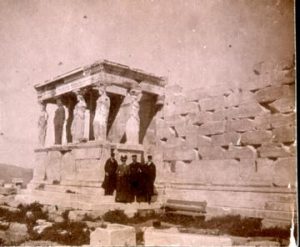“Even in ruins an imposing and soul-stirring object”
Baedeker’s Greece (1889), on the Parthenon
Half a century after gaining independence, Greece became a popular destination for adventurous tourists. The first guidebook to Greece, Baedeker’s Athens and Its Immediate Environs, was published in 1871, followed by Baedeker’s Greece in 1883. An infrastructure of hotels, restaurants, and railroads developed throughout Greece, making it easier to travel in comfort. In Athens, tourists could visit the Acropolis during the day and, around the time of the full moon, they could enjoy a romantic nighttime experience of the ruins in the cool Mediterranean moonlight.
Restorations on the Acropolis itself were soon initiated. Terracotta replicas of sculptures replaced missing or damaged originals and bricks were used to stabilize the structures. The so-called “Frankish Tower” was removed from the Proplylaia in the summer of 1875. By then the four Periclean buildings displayed ancient sculpture for tourists and, after metal gates were inserted, shielded them from eager souvenir hunters. A museum on the east end of the Acropolis opened in 1874.
Tourists acquired images of the archaeological sites from local photographers and later gathered them in travel albums, compiled as keepsakes. Stereoscopic views provided early “virtual reality” experiences, albeit in black-and-white. Snapshot cameras came into circulation after 1888 when George Eastman marketed the first Kodak camera, allowing tourists to capture their own images as photographic souvenirs.
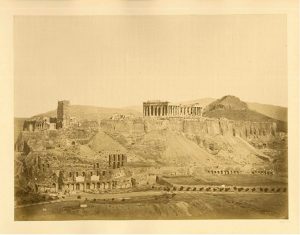
(PR) (PA)
Dimitrios Konstantinou (Greek, active 1858–1860s)
General view of the Athenian Acropolis and the South Slope from the southwest, c. 1860–1865
Purchase with funds provided by the Fine Arts Acquisition Fund
2013.019.59
Once Dimitrios Konstantinou opened his studio in Athens in 1858 (see No. 11), he began to cater to the growing number of visitors eager to acquire photographs of the monuments they had visited. This photograph comes from an album compiled by American tourists in the last quarter of the nineteenth century.
This view was a particularly popular one and exists in many versions taken by a variety of photographers, Greek and foreign alike. Taken from the Philopappos Monument on the Hill of the Muses, the photograph captures the Acropolis as a whole, featured against the mountains towards Marathon and Mount Lykavittos. The Parthenon at the very center of the images is majestically framed by the Frankish Tower and Mount Lykavittos. Below are visible the enormous dumps left by the cleaning operations on the Acropolis undertaken by the Greek Archaeological Society.
Petros Moraites (Greek, c. 1835–1905)
A native of the island of Tinos, Petros Moraites studied painting in Athens. In 1859 he learned photography from Athanasios Kalphas (Greek, active mid-19th century) and joined him as his business partner. In 1860 Moraites set up his own studio and became a society photographer. Around 1868 he became the first Greek to hold the title of “Photographer to His Majesty the King.”
Moraites also catered to the growing number of tourists visiting Greece. The following six photographs, five of which are signed by the artist, come from the same tourist album that contained the Konstantinou photograph (No. 17). Tourism and photography developed hand in hand: by 1891 there were no fewer than 27 photography studios in Athens.
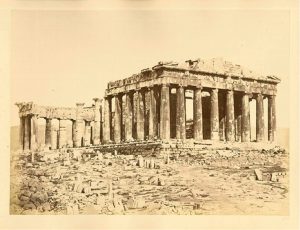
(PA)
The Parthenon from the southwest, 1870
Purchase with funds provided by the Fine Arts Acquisition Fund
2013.019.63
Taken from just inside the Propylaia, this classic view shows the Parthenon, free of all surrounding post-antique structures, prior to the Balanos reconstructions of the 1890s. The structure nearly fills the entire width of the photograph, towering over the Acropolis now stripped bare to bedrock. Moraites took several near-identical photographs from this position.
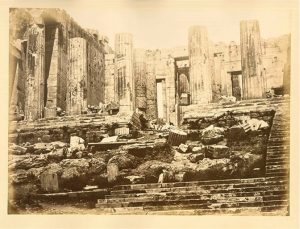
(PR)
The Propylaia from the west, 1870
Purchase with funds provided by the Fine Arts Acquisition Fund
2013.019.72
Designed by the architect Mnesicles and constructed between 438 and 432 BCE, the Propylaia served as the gatehouse into the Acropolis. It survived more or less intact until the late-medieval period, when it was converted into the palace of the Acciaioli family, who ruled the Duchy of Athens from 1388 to 1458. The Ottomans used the structure as a powder magazine. When it exploded in 1656, more damage was done than at any other time during its history.
Moraites focuses on the steps leading up to the forest of columns and walls of the Propylaia featured dramatically from below. In the foreground are remains of the Mycenaean ramp that gave access into the Bronze-Age citadel.

(AN)
Temple of Athena Nike, 1865–1869
Purchase with funds provided by the Fine Arts Acquisition Fund
2013.019.74
Designed by Callicrates, the Temple of Athena Nike was constructed between 427 and 423 BCE. The delicate Ionic building was demolished in 1686 when its blocks were recycled into an Ottoman fortification. Some of the sculpted frieze blocks were moved to London in the early 19th century as part of the Elgin Marbles. The building was reconstructed by the French architect Émile Laurent in 1836 and came to stand for the rebirth of the Greek nation. A decade later, in 1846, casts of the frieze were added.
Moraites shows the temple from the east, with part of the Frankish Tower visible on the right. The inclusion of a Greek in traditional dress leaning against the northeast column provides a sense of scale.

(ER)
The Erechtheion, 1870
Purchase with funds provided by the Fine Arts Acquisition Fund
2013.019.64
Moraites’ photograph is much more readable than Stillman’s image taken the year before (No. 15). Like with his view of the Parthenon (No. 18), Moraites’ photograph became a canonical view of the structure, and most popular with tourists.
The Erechtheion burned during the first century BCE and was restored by Augustus, the first Roman Emperor. It later served as a Byzantine church, a Frankish ducal palace, and housing for an Ottoman harem.

(NA)
Temple of Hephaistos, c. 1870
Purchase with funds provided by the Fine Arts Acquisition Fund
2013.019.67
The Temple of Hephaistos was constructed in the middle of the fifth century BCE. It has been attributed, somewhat tentatively, to the so-called “Theseum Architect.” It is the best-preserved temple in all of Greece. Converted into a church in the seventh century CE, it remained in use as such under Ottoman rule. The last church service took place in 1834, after which the temple became the National Museum of Greece.
In this view Moraites captures the western and better-preserved end of the temple perched atop the Agoraios Kolonos hill.

(NA)
Temple of Zeus from the southeast, c. 1870
Purchase with funds provided by the Fine Arts Acquisition Fund
2013.019.68
The Olympieion, a large temple dedicated to Olympian Zeus, was initiated by the Peisistratids, the tyrants of Athens, in the sixth century BCE. The building was completed—in reality entirely rebuilt—by the Roman emperor Hadrian in the first half of the second century CE.
This photograph depicts the cluster of Corinthian columns that remained standing on the southeast corner of the temple, visually linked to the Acropolis in the background. Together with the nearby Arch of Hadrian, it had become a popular tourist site by the time the image was created. Note the café set up in the shade of the columns.
Though unsigned, the photograph may be attributed to Moraites on the basis of size, technique, composition, and parallels to other images of the same monument taken by him.
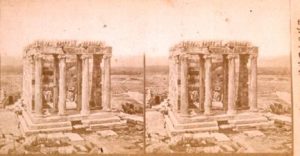
(AN)
Frank Mason Good (British, 1839–1911)
Athens—The Temple of Victory (Eastern Series, No. 353), c. 1866–1867
Stereograph (albumen print mounted on card)
Gift of an anonymous donor
2004.036
Frank Mason Good, best known today for his photographs of the Middle East, was in Greece in 1866 or 1867. He was an early practitioner of stereoscopic photography, which provided a three-dimensional image. Stereoscopic photography became widely popular in the last decades of the 19th century.
This stereo pair depicts the facade of the Temple of Athena Nike, taken more or less at the same time as a photograph taken by Moraites (No. 20). Both were taken prior to 1869, when the iron gates that appear in some of Stillman’s photographs were installed.

